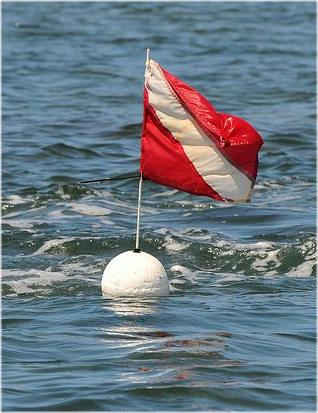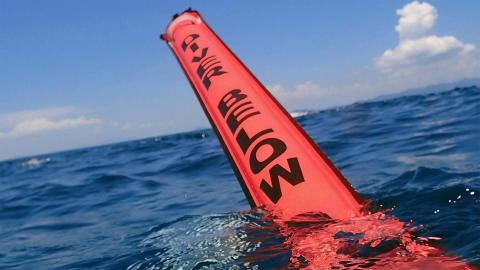

Dive Flag
Recognized Indicator of In-Water Diver
SMB
May not be recognizable to boating community
On
Using SMBs
by
Larry
"Harris" Taylor, Ph.D.
This material is
copyrighted and all rights retained by the author. This article is made
available as a service to the diving community by the author. This article may
be distributed for any non-commercial or Not-For-Profit application.
All
Rights Reserved.
Go To: Home About "Harris" Articles War Stories Editorials Links Fini
Many solo classes require a surface marker buoy (SMB) ... this often is an expensive brightly colored (fluorescent green or orange) safety-sausage-like tube bearing the words "Diver Down" or "Diver Below." Many states, however, have legal requirements stating that a submerged diver must display (either on a towed float or on a vessel) the red "diver's down" flag ... typically a minimum size is listed. This suggests that only using a SMB may not be legally compliant. An example of the Michigan law:
Michigan Act 451 of 1994324.80155
Any person diving or submerging in any of the waters of this state with the aid of a diving suit or other mechanical diving device shall place a buoy or boat in the water at or near the point of submergence. The buoy or boat shall bear a red flag not less than 14 inches by 16 inches with a 3-1/2 inch white stripe running from 1 upper corner to a diagonal lower corner. The flag shall be in place only while actual diving operations are in progress. A vessel shall not be operated within 200 feet of a buoyed diver's flag unless it is involved in tendering the diving operation. A person diving shall stay within a surface area of 100 feet of the diver's flag.
Boater safety courses inform the boating community of the significance of the diver's flag.
|
|
 |
|
|
Dive Flag Recognized Indicator of In-Water Diver |
SMB May not be recognizable to boating community |
On the practical side, dive flag assemblies typically display an upright flag (see above, left) which facilitates visibility and recognition. The SMB tends to not be upright when moving through the water (see above, right). This limits its visibility to boaters.
The SMB may not be recognized, especially from a distance, by boaters as a warning of a submerged diver's presence.
The dive flag establishes a legal zone of protection for the diver; this protection is, most likely, not available with the SMB. Law enforcement will enforce this protection (see Dive Flag Incident ).
I should also point out that in my decades of diving in Michigan waters, I have had DNR officers and county sheriffs approach me in pre- or post dive situations to query me and others present about the presence of a dive flag.
.
Finally, some states / cities have legal requirements on diving. For example:
The Ohio DNR requires anyone aged 17 or younger to dive in the presence of someone 21 years of age or older.
The city of Detroit prohibits swimming, water skiing, surfboarding, wind surfing, and skin diving in all public waters including fountains. The city also requires that any Detroit River diving be done such that face and hands are not water accessible.
Bottom Line: Divers using SMB's should check local and state laws to ensure compliance with existing statutes.
Go To: Home About "Harris" Articles War Stories Editorials Links Fini
About
The Author:
Larry "Harris" Taylor, Ph.D. is a biochemist and Diving Safety Coordinator at the University of Michigan. He has authored more than 200 scuba related articles. His personal dive library (See Alert Diver, Mar/Apr, 1997, p. 54) is considered one of the best recreational sources of information In North America.
All rights reserved.
Use of these articles for personal or organizational profit is specifically denied.
These articles may be used for not-for-profit diving education